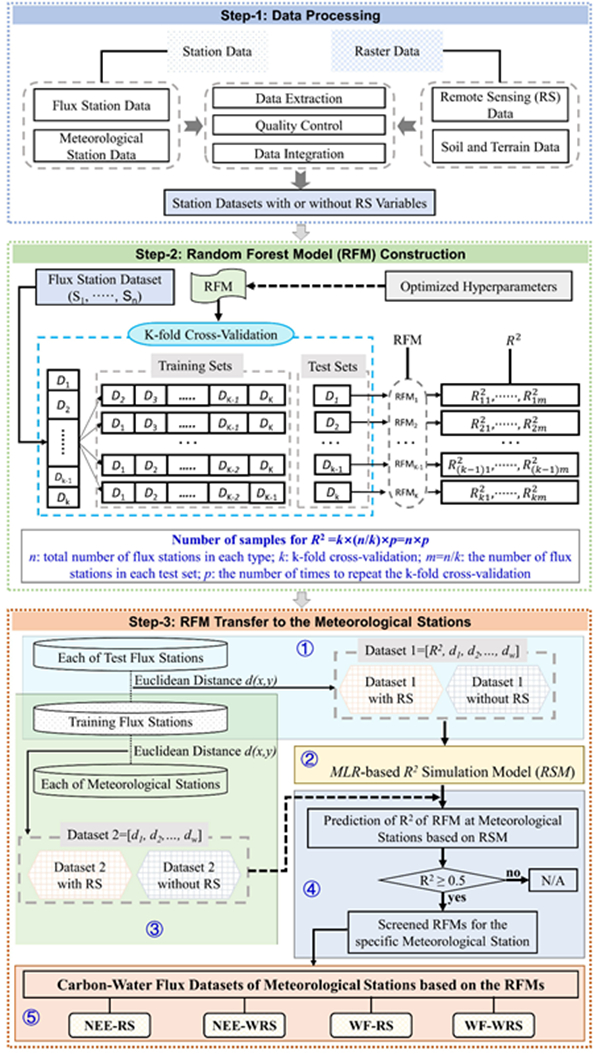CAS-XIEG Breakthrough: Mining Ecosystem Carbon-water Flux Information with Quasi-observational Properties at Meteorological Stations
2023-10-11
The sparse and uneven distribution of the eddy covariance flux stations has hindered the study of carbon-water cycles in terrestrial ecosystems. The mining of carbon-water flux information from more widely distributed meteorological stations shows great potential for dealing with this challenge. With the development of artificial intelligence and big data technology, it has become possible to build a bridge between sparsely distributed the eddy covariance flux stations and widely distributed meteorological stations, and to mine carbon flux information with "quasi observation" attributes from meteorological stations.
Prof. Luo Geping’s research team at the Xinjiang Institute of Ecology and Geography of Chinese Academy of Sciences developed the technology and method for mining ecosystem carbon-water flux information at meteorological stations. Four carbon and water flux datasets with quasi-observational properties were constructed in the study. This work was published in Scientific Data.
This project is based on the second law of geography (spatial heterogeneity law) and machine learning algorithms to develop hundreds or thousands of ecosystem carbon flux models. Then, based on the first law of geography (spatial correlation law) and the third law of geography (similarity law), with the determination coefficient (R2) and Euclidean distance as links, an applicability evaluation framework and method system for migrating hundreds or thousands of ecosystem carbon flux machine learning models to meteorological stations were established, which solved the applicability of model migration and significantly reduced the uncertainty of model spatial migration. This is the originality and scientificity of this study.
Thousands of the random forest models (RFM) were built using flux station data, thus generating thousands of determination coefficients (R2) at test stations. Based on the R2 and Euclidean distance, the R2 simulation model was built by using multiple linear regression to evaluate the applicability of RFM on meteorological stations. So that the RFMs can be transferred to meteorological stations to simulate the carbon-water fluxes.
The results indicated that 84.5% and 99.1% of the meteorological stations (N=4466) could produce the daily carbon and water fluxes when using remote sensing (RS) variables in the RFM construction, respectively. Without the use of the RS variables, 68.2% and 98.7% of the meteorological stations (N=6849) could produce the daily carbon and water fluxes, respectively.

Fig. 1 Research framework. R2, determination coefficient; MLR, multiple linear regression. N/A (not applicable) indicates that the RFM could not be transferred to the specific meteorological stations. NEE-RS: net ecosystem exchange (NEE) based on the RFM with remote sensing (RS); WF-RS: water flux (WF) based on the RFM with RS; these explain the fact that the RS variables were used in the RFM construction. NEE-WRS: NEE based on the RFM without RS; WF-WRS: WF based on the RFM without RS; these demonstrate that the RS variables were not applied in the RFM construction. RS variables include the fraction of the photosynthetically active radiation, enhanced vegetation index, land surface water index and surface reflectance for the Moderate Resolution Imaging Spectroradiometer bands 1–7. (Image by Prof. LUO Geping’s gruop)
The research results of this study can be used for precise carbon sequestration accounting throughout the entire life cycle of ecological carbon sequestration forests, degraded grassland restoration projects, or protected areas established. It is expected to provide technical, methodological, and data support for ecological carbon sink accounting and carbon sink trading in the "carbon neutrality" goal. The research ideas and methods created in this project can also be applied to relevant model research in the field of geographical ecology, significantly improving its simulation accuracy. This study can provide technical, methodological, and data support for ecological carbon sink accounting and carbon sink trading in the "carbon neutrality" goal.
The study was done at Xinjiang Institute of Ecology and Geography, Chinese Academy of Sciences.
The work was supported by the Tianshan Talent Cultivation, the Key Projects of the Natural Science Foundation of Xinjiang Autonomous Region and the China Scholarship Council.
Contact:
Luo Geping
Xinjiang Institute of Ecology and Geography, Chinese Academy of Sciences
Phone: 86-13899875832
E-mail: luogp@ms.xjb.ac.cn



